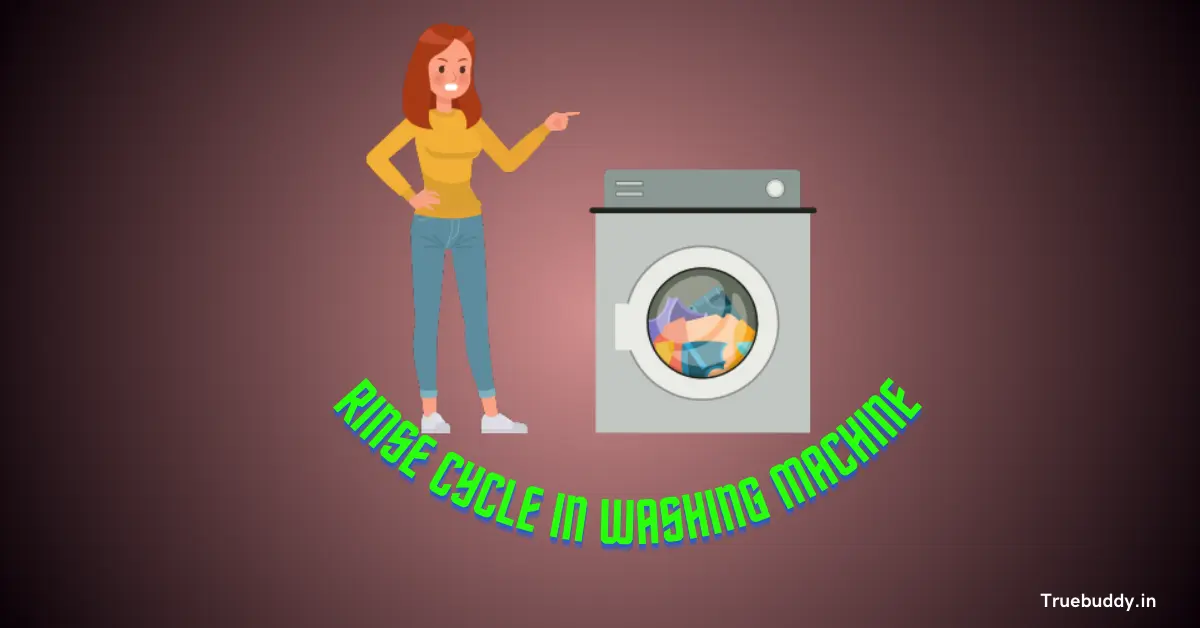Step into the realm of laundry, where an unsung hero quietly takes center stage—the Rinse in Washing Machine. Despite its unassuming name, this humble cycle holds incredible powers of cleanliness and garment rejuvenation.
It’s a world where water works its magic, bidding farewell to stains and restoring fabrics to their former glory.
You may also like:
- What is Cradle Wash in IFB Washing Machine: A Gentle Care for Your Delicates
- Difference Between Front Load and Top Load Washing Machine
- What is 4C Error in Samsung Washing Machine? Know How to Fix it.
- What is wash, rinse and spin in Washing Machine?
If you’ve recently purchased a washing machine, understanding all the functions and programs can be overwhelming. One function that often goes unnoticed is the rinse cycle. Rinsing washing machine is often considered a waste of time.
However, the rinse in washing machine actually serves an important purpose and shouldn’t be underestimated.
Unfortunately, many washing machine owners are unaware of what the rinse cycle does. Today, we will explore the concept of the rinse cycle in a washing machine. We will also know how to utilize this function effectively. So let’s uncover the fascinating facts behind the Rinse in Washing Machine.

What is the Rinsing Washing Machine and Its Role?
When we refer to rinsing washing machine it essentially means washing the clothes further. The rinse cycle typically follows the initial wash cycle. This process occurs due to the centrifugal force generated by the washing machine, although it’s not necessary to delve into the technical details. Simply put, the rinse cycle is a crucial step that aids in thoroughly cleaning and drying your clothes.
Understanding Wash and Rinse in Washing Machine
To comprehend the rinse cycle better, let’s examine the three cycles involved in washing clothes using a washing machine.
i. Prewash Cycle
The prewash cycle is the first step, which helps loosen dirt, dust, and stains from the clothes before the main wash. It prepares the garments for effective cleaning.
ii. Wash Cycle
Following the prewash, the wash cycle takes place. This cycle removes any residual soap from the fabric, ensuring the clothes are clean and ready for drying.
iii. Rinse Cycle
The rinse cycle, as the name suggests, ensures there are no soap residues left on the clothes. Additionally, it helps prevent the clothes from becoming stained during the drying process. Some washing machines offer a “simple rinse” option, suitable for lightly soiled clothes with minimal stains. However, heavily soiled garments require a complete wash cycle for thorough cleaning.
Key Differences between the Wash and Rinse Cycles
In the washing process, there are notable distinctions between the wash and rinse cycles. Let’s explore these differences:
During the wash cycle, soapy water enters the drum, with the water temperature varying based on your settings—cold or warm. Detergent is added to the wash cycle, which primarily targets heavy dirt and stains. The duration of the wash cycle can be as long as 50 minutes, depending on the chosen settings. At the end of this cycle, any dirty or excess water is drained through the hose.
The rinse cycle utilizes fabric softener, which was added during the initial cycle, to maintain the quality of the clothing materials. Clean water is used in this phase to remove the remaining dirt and stains left from the wash cycle.
Understanding Wash, Rinse, and Spin Cycles: A Breakdown of the Washing Process
The washing process can be broken down into three distinct steps: the wash cycle, rinse cycle, and spin cycle.
The wash cycle involves adding detergent and water to the machine for cleaning the clothes. Soapy water enters the drum and undergoes agitation, effectively removing dirt and stains.
Once the wash cycle completes its job, the rinse cycle commences by washing the clothes with clean water, eliminating excess detergent.
Next, in the spin cycle, the drum spins at high speed to extract excess water from the clothes, making them easier to dry. This cycle completes the washing process and prepares the clothes for subsequent drying.
How to Properly Use the Rinse in Washing Machine?
Now that you understand the significance of the rinse cycle, it’s essential to utilize it correctly for efficient clothes cleaning. If your washing machine has a separate “simple rinse” program, follow these steps:
Select the rinse washing program on your machine. This option is suitable for clothes that are lightly soiled with minimal stains.
However, if your garments are heavily soiled or contain stubborn stains, a simple rinse wash won’t be sufficient. In such cases, opt for a complete wash cycle to ensure thorough cleaning.
What is the Duration of the Rinse Cycle?
While a regular wash cycle can take up to 50 minutes, a simple rinse program typically lasts between 15 and 30 minutes.
The Consequences of Skipping the Rinse Cycle
Every step in the washing machine process is crucial, and skipping any part can lead to adverse effects. Prewash, wash, rinse, spin, and drying—each step plays a vital role in efficiently cleaning your clothes. Neglecting to use these programs completely can result in damaged clothes or unsatisfactory results.
Not using the rinse cycle can be particularly detrimental to your clothes’ fabric. The rinse cycle helps remove any soap residue from the fabric and prevents staining during the drying process. Thus, it is essential to utilize the rinse cycle after the wash cycle.
Benefits of Using the Rinse in Washing Machine?
The rinse cycle in a washing machine may often be overlooked or considered unnecessary by some, but it actually offers several benefits that contribute to achieving cleaner and fresher laundry. Let’s know the advantages of using the rinse cycle in washing machine:
Removal of Soap Residue
One of the key benefits of the rinse cycle is its ability to remove any left-out soap residue from your clothes. During the wash cycle, detergent is used to lift away dirt and stains. However, without a proper rinse, some detergent may remain trapped in the fabric fibers. The rinse cycle ensures thorough rinsing, leaving your clothes free from any residual soap that can cause stiffness, dullness, or skin irritations.
Enhanced Cleanliness
By using the rinse cycle, you get cleaner laundry. The additional rinse with clean water helps to flush out any remaining dirt, particles, or detergent that may not have been fully eliminated during the wash cycle. This extra step ensures that your clothes are thoroughly cleansed and freshened.
Preservation of Fabric Quality
The rinse cycle also plays a role in preserving the quality and longevity of your garments. By removing soap residue, it prevents the accumulation of detergent that can cause fabrics to become stiff, lose their softness, or fade over time. Additionally, rinsing helps to minimize the risk of detergent buildup that may attract and hold onto dirt or other contaminants, which can gradually damage the fabric fibers.
Stain Prevention
The rinse cycle aids in preventing stains from setting on your clothes. Some stains may not be completely removed during the wash cycle. The rinse cycle provides an additional opportunity to flush out any remaining particles that may lead to stubborn stains. By thoroughly rinsing the clothes, you increase the chances of maintaining stain-free garments.
Fresh Scent and Comfort
Utilizing the rinse cycle contributes to achieving a fresh scent for your laundry. Removing soap residue and any lingering odors ensures that your clothes come out of the washing machine smelling clean and revitalized. Rinsing washing machine makes clothes more comfortable to wear.
Frequently Asked Questions about Rinse in Washing Machine
What is the purpose of the rinse in washing machine?
The rinse cycle helps to remove soap residue from your clothes. It ensures they are thoroughly cleansed and free from any remaining detergent.
How does the rinse cycle work?
During the rinse cycle, the washing machine fills with fresh water and agitates the clothes to rinse away any remaining soap and particles.
Do I need to use the rinse cycle for every wash?
While it’s not always necessary, using the rinse cycle is recommended to ensure your clothes are fully clean and free from soap residue.
How long does the rinse cycle typically last?
The duration of the rinse cycle can vary depending on the washing machine model and the specific program selected. On average, it usually lasts 15-20 minutes.
Can I use fabric softener during the rinse cycle?
Yes, the rinse cycle is an ideal time to add fabric softener. It helps to further enhance the softness and freshness of your clothes.
Should I use hot or cold water for the rinse cycle?
Using cold water for the rinse cycle is generally recommended. Cold water helps to remove soap effectively while also conserving energy.
Can I use the rinse cycle for delicate fabrics?
Yes, the rinse cycle is suitable for delicate fabrics. However, always check the garment’s care label to ensure it can withstand machine washing and adjust the settings accordingly.
What happens if I skip the rinse cycle?
Skipping the rinse cycle may result in your clothes retaining soap residue, which can make them feel stiff, look dull, and cause skin irritations. It’s best to include the rinse cycle for optimal cleanliness.
Conclusion
The rinse cycle in washing machines offers valuable benefits that go beyond just removing soap residue. It helps to enhance cleanliness, preserve fabric quality, prevent stains, and provide a fresh and comfortable laundry experience.
So, embrace the hidden power of the rinse cycle and witness the remarkable difference it makes in the cleanliness and longevity of your garments. Say goodbye to dull, stiff clothes and embrace the freshness that comes with a properly rinsed load of laundry.
- Best Non-Stick Tawa for Easy Roti Making - October 5, 2024
- Best Towel Racks to Keep Your Bathroom Organized and Tidy - October 5, 2024
- Upgrade Your Bathroom with the Best Mirror Cabinets in India - October 5, 2024
